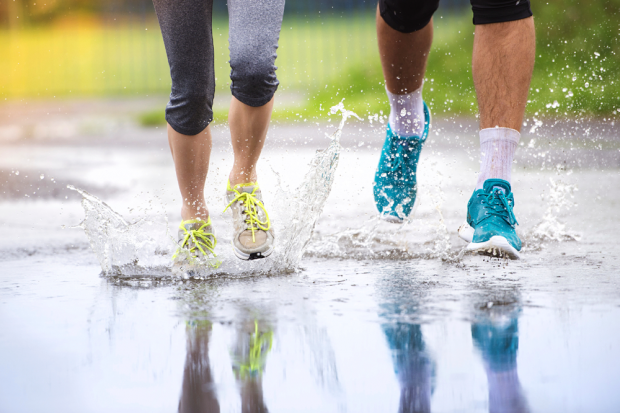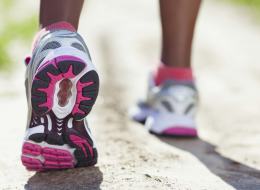Post Hibernation Hints 10 Bright Tips For Springtime Running and Walking
Before you shake off cabin fever with your first outdoor run, hike or walk of the season, use this fitness guide to avoid painful springtime workout injuries.
Birds are chirping, leaves are sprouting, flowers are blooming, and you are raring and ready to get back into the great outdoors after a long winter. But before you come out of hibernation with the first run, hike or extended walk of the spring season, follow these tips to avoid painful injuries and get the most out of your springtime workouts.
Steps To Take Before You Go, Go, Go!
1. Stretch
Whether you’ve been keeping active throughout the winter at an indoor gym or if you’ve just been a lazy couch potato, it’s always a good idea to engage in some muscle-relaxing stretches several days before and leading up to your first walk, jog or hike of the season. A mix of static stretches and dynamic stretches helps warm up and loosen your muscles, tendons and ligaments so you can avoid common injuries like plantar fasciitis and shin splints.
2. Start Slow and Set Realistic Goals
Speaking of plantar fasciitis and shin splints, these and many other “overuse injuries” are caused by too much physical activity too soon for your body to handle. If it’s been awhile since you did strenuous exercise, it’s much better for you to take a short walk or run rather than to shoot out of the gate with a 5k marathon. Beginner runners should start out by walking 10 to 20 minutes, then jogging for 10 minutes, and then resuming walking for 10 minutes a couple of times of week. People who haven’t jogged in a couple of months should shoot for steady, 20 minute runs a couple of times per week. You should also never run two days in a row when you’re just starting out. Your body will thank you!
3. Check Your Jogging or Hiking Shoes
Before you even think about hitting the trail, be sure to thoroughly examine your running, walking or hiking shoes. Most athletic shoes only last six months to a year, depending on usage. Shoes that are old, uncomfortable or show signs of serious wear and tear should be switched out for new footwear.
4. Break In New Shoes
If you do have to spring for a new pair of jogging or hiking shoes, be sure to slowly break them in starting a couple of weeks before you plan any long distance treks. Wear the shoes around the house for a few hours a day followed by some short jogs or hikes to avoid painful calluses, corns and blisters that often accompany wearing brand new shoes.
5. Examine and Replace Your Orthotics
Many walkers, runners and hikers use orthotic devices (orthoses) such as arch supports to help keep physical activity comfortable. These gait-friendly tools work wonders, but they too wear out and need to be replaced from time to time. Bring them in to your podiatrist or other doctor if they don’t feel right or if you think they may need to be updated.
6. Dress Appropriately
Spring is a finicky season, and you never know what you’re going to get weather-wise. Therefore, it’s helpful to dress in layers so you can take off or put on whatever gear you need to keep at a comfortable temperature. Lightweight, moisture-wicking apparel is best, especially during chilly and drizzly days. Wearing non-cotton, moisture wicking socks is also important, as they can help you avoid blisters and fungal infections like athlete’s foot that often arise when the feet are wet and soggy for long periods of time.
7. Stay Hydrated
Our bodies are made up of 90 percent water, so it’s important to keep the hydration flowing during your fitness routine. Drink plenty of water both before, during and after your run, walk or hike in order to ensure healthy blood circulation, which helps keeps your muscles, ligaments and tendons healthy, loose and cramp free. Staying hydrated also keeps you endurance strong; dehydration can lead to sluggishness and dizziness during your hike, walk or run.
8. Transition to the Outdoors
If you’ve been walking or jogging on a treadmill during the winter months, you’ll need to take a little time to acclimate your body to the tougher terrain of the outdoors. The surface area of a jogging path or hiking trail isn’t as predictable as the steady “path” the training equipment at the gym provides, especially if the ground is wet and slippery. Start out by taking smaller strides and avoiding too much incline or decline in the first couple of weeks you resume outdoor running, walking and hiking. Runners should avoid concrete and opt for joint-friendly dirt paths and spongy outdoor tracks.
9. Watch Out For Puddles, Mud and Ice
Spring brings sunshine, but traces of winter can still pop up during your run, walk or hike. Be on the lookout for unexpected patches of ice in shadowy areas and slippery puddles of mud, both of which can lead to scary slips, trips and falls that cause bruises, sprains, bone fractures and other painful symptoms.
10. Listen To Your Body
You should never feel pain while engaging in any type of physical activity, provided you warmed up properly and are wearing comfortable, well-fitted shoes appropriate for the type of activity you’re doing. Pain is a signal that something is wrong, so you should never “push through” the discomfort or ignore it. If you do feel toe, foot or leg pain while jogging, walking or hiking, you should schedule a checkup with your doctor or podiatrist. Injuries like stress fractures, shin splints, plantar fasciitis and ankle sprains will only get worse with time, and quick care can eliminate the need for extended, goal-derailing breaks from springtime runs, walks and hikes.
Notice concerning medical entries:
Articles having medical content shall serve exclusively for the purpose of general information. Such articles are not suitable for any (self-) diagnosis and treatment of individual illnesses and medical indications. In particular, they cannot substitute for the examination, advice, or treatment by a licensed physician or pharmacist. No replies to any individual questions shall be effected through the articles.






